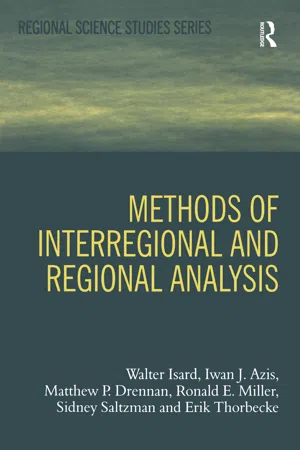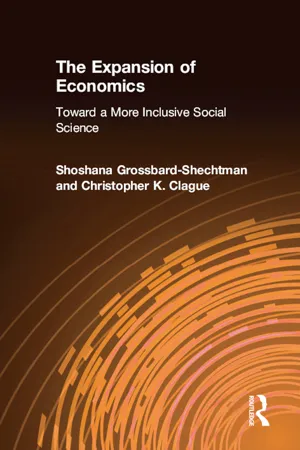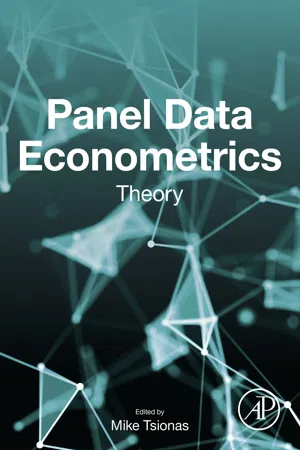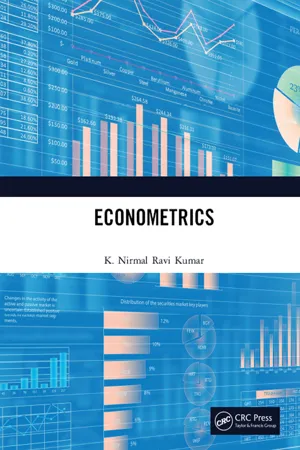Business
Econometric Methods
Econometric methods refer to the application of statistical and mathematical techniques to analyze economic data and test economic theories. These methods are used to quantify and evaluate the relationships between different economic variables, such as supply and demand, inflation and unemployment, and the impact of policies on the economy. Econometric methods are widely used in business to make informed decisions and forecasts based on empirical evidence.
Written by Perlego with AI-assistance
Related key terms
Related key terms
1 of 4
Related key terms
1 of 3
6 Key excerpts on "Econometric Methods"
- eBook - ePub
- Walter Isard, Iwan J. Azis, Matthew P. Drennan, Ronald E. Miller, Sidney Saltzman, Erik Thorbecke(Authors)
- 2017(Publication Date)
- Routledge(Publisher)
chapter 9 ). Furthermore, Econometric Methods are used to model regional phenomena that other regional science methods are unable to handle, such as time dependent relationships among socio-economic variables. In addition, the careful analysis and examination of a data set and its resultant model may spark the development of a new theory to explain some regional phenomena. For such a new theory to be credible, it is necessary to test its validity on a different data set that was not used previously to develop the new theory.Econometrics may be defined, very briefly, as the application of statistical methods to economic data, but that does not tell the full story of how Econometric Methods are used in the analysis of economic phenomena. An econometric analysis should begin with the formulation of a mathematical model that is grounded in economic theory. That model is then specified in a form that can be tested with data using appropriately selected techniques based on statistical theory. The results of testing the model are then analyzed in order to determine whether or not the underlying economic theory provides a satisfactory explanation of the empirical results. Unfortunately, this process is not implemented as cleanly as it is described here and there is much reformulation, respecification, reselection and retesting required in a typical econometric analysis.In this chapter, we provide a brief and somewhat intuitive introduction to econometric analysis which focuses primarily on the selection process for deciding which statistical techniques are most appropriate in a given application. In addition, we provide some examples to illustrate these applications to real-world problems in a regional setting, and some discussion of the ‘art’ of econometric model building.In addition to the more conventional models and types of applications of regression methods of interest to us here, we also examine other types of econometric models that have special relevance for regional analysis. These include brief introductions to the use of dummy variables, discrete choice models, pooled cross section and time series models, simultaneous equations models, and spatial econometric models. Where appropriate, applications are integrated with discussions of the statistical methodology and are used to illuminate some of the underlying statistical issues. - eBook - ePub
- Ping Zong(Author)
- 2022(Publication Date)
- Routledge(Publisher)
However, this definition never means that a single one of these aspects can be taken by itself for econometrics. Econometrics is by no means the same as economic statistics. Nor is it identical with what is generally called economic theory, although a considerable portion of this theory has a definitively quantitative character. Nor should econometrics be taken as synonymous with the application of mathematics to economics. Experience has shown that each of these three viewpoints, that of statistics, mathematics, and economics, is a necessary, but not by itself a sufficient condition for real understanding of the quantitative relations in modern economic life. It is the unification of all three powerful components. It is this unification that constitutes econometrics.Today, econometrics has been a unified study of economic theory, mathematical statistics, and economic data. Within the field of econometrics, there are sub-divisions and specialisations: theoretical econometrics and applied econometrics. The econometric theory concerns the development of econometrics and the study of the properties of Econometric Methods, while applied econometrics is a term describing the development of quantitative economic models and the application of Econometric Methods to economic problems using economic data.Both these econometric sub-divisions use statistical methods as an econometric foundation; i.e., the statistics foundation (metrics) was applied to economics, therefore, it is called ‘econometrics’. Indeed, the statistics foundation (metrics) can be applied to many different disciplines such as psychometrics, sociometric, chemometrics, technometrics, morphometrics, environmetrics, and even cliometrics (history).Econometrics is an application of statistics and is exclusively focused on using statistical methods for economic problems. There are many overlapping areas of interest between econometrics and statistics such as linear models, hypothesis testing, graphical models for causal or non-causal inference, multiple testing, re-sampling, and time series analysis. Despite this, there are still some differences between econometrics and statistics from sociological as well as scientific views of points. For instance, econometrics is highly focused on discovering the causal relationships based on the economic theory; however, there are often unique statistical problems in statistical models. Some economic causality arose in specific applications that statisticians may be unaware of, or may not be of interest. The ‘Two-Step Estimators’ to analyse the economic problem in econometrics may be one of the examples. Econometricians are typically interested in capturing causal effects from observed data, and the models they used usually need to be justified by some economic theory more than by goodness of fit only. - eBook - ePub
- Jean Dubé, Diègo Legros(Authors)
- 2014(Publication Date)
- Wiley-ISTE(Publisher)
1
Econometrics and Spatial Dimensions
1.1. Introduction
Does a region specializing in the extraction of natural resources register slower economic growth than other regions in the long term? Does industrial diversification affect the rhythm of growth in a region? Does the presence of a large company in an isolated region have a positive influence on the pay levels, compared to the presence of small-and medium-sized companies? Does the distance from highway access affect the value of a commercial/industrial/residential terrain? Does the presence of a public transport system affect the price of property? All these are interesting and relevant questions in regional science, but the answers to these are difficult to obtain without using appropriate tools. In any case, statistical modeling (econometric model) is inevitable in obtaining elements of these answers.What is econometrics anyway? It is a domain of study that concerns the application of methods of statistical mathematics and statistical tools with the goal of inferring and testing theories using empirical measurements (data). Economic theory postulates hypotheses that allow the creation of propositions regarding the relations between various economic variables or indicators. However, these propositions are qualitative in nature and provide no information on the intensity of the links that they concern. The role of econometrics is to test these theories and provide numbered estimations of these relations. To summarize, econometrics, it is the statistical branch of economics: it seeks to quantify the relations between variables using statistical models.For some, the creation of models is not satisfactory in that they do not take into account the entirety of the complex relations of reality. However, this is precisely one of the goals of models: to formulate in a simple manner the relations that we wish to formalize and analyze. Social phenomena are often complex and the human mind cannot process them in their totality. Thus, the model can then be used to create a summary of reality, allowing us to study it in part. This particular form obviously does not consider all the characteristics of reality, but only those that appear to be linked to the object of the study and that are particularly important for the researcher. A model that is adapted to a certain study often becomes inadequate when the object of the study changes, even if this study concerns the same phenomenon. - eBook - ePub
The Expansion of Economics
Toward a More Inclusive Social Science
- Shoshana Grossbard-Shechtman, Christopher K. Clague(Authors)
- 2016(Publication Date)
- Routledge(Publisher)
b. high levels of simultaneity in systems. The residuals from a vector autoregression are likely to have high cross-correlations, for example. This suggests that a lot is happening in the economy at short time intervals that is not captured in a reduced form. This may represent a data collection or measurement problem. It is a classical controversy as to whether variables are related strictly simultaneously.c. Many economic time series are persistent, containing deterministic trends and unit root components, and possibly other so-called long-memory processes. Because of these properties many classical techniques cannot be used, and it has been necessary to develop new methods, based on novel mathematics. Some of these ideas, such as “cointegration,” can be linked with basic economic concepts such as some forms of equilibrium. A number of methods developed for economic data have been used successfully in other areas, such as political science and sociology.All the activities of econometricians rest on basic statistical foundations that have been developed in particular directions to account for the properties of economic data. ConclusionsI have often found it advantageous to have been trained as a statistician rather than as an economist, as I will come to a problem from a viewpoint different from that of my colleagues. I believe that it is better to have several specifications of a model available to compare and evaluate rather than just one. Team members having different backgrounds are likely to produce such alternative specifications.The biggest differences this survey has found between economists and statisticians are in the attitudes toward data, toward the correctness of theory, the importance of policy and control, the use of correct evaluation, and the use of realistic experiments. I hope that the two groups will continue to intermingle and learn from each other, like citizens of different countries facing similar problems.Notes1 . This definition does not correspond to members of the Econometric Society, who can be only mathematically sophisticated economic theorists.2 - eBook - ePub
Panel Data Econometrics
Theory
- Mike Tsionas(Author)
- 2019(Publication Date)
- Academic Press(Publisher)
We begin by outlining some fundamental concepts that lie behind much of what goes on in econometrics: the idea of a population, random variables, random sampling, the sampling distribution, and the central limit theorem. We then explore two of the basic approaches to constructing an econometric estimator: the maximum likelihood principal and the general method of moments. We then go through the standard linear model, the basic workhorse of econometrics, and the various problems that can arise in this familiar case. We then explore the issue of nonstationarity, which has dominated many of the developments in econometrics during the last 30 years.2 Some Basic Concepts
At its heart, econometrics is about quantifying effects in the real world and assessing these effects to gain some notion of their reliability. Economic theory often can suggest the direction of a causal effect, but it rarely suggests the exact magnitude of such an effect nor what the correct functional form should be. To make the realm of econometrics operational, we need a statistical framework that allows us to operate in a wide range of situations, at least to a good approximation of the real world. This framework begins with the concept of the population. We assume that there is an infinitely large population of events or outcomes that are of interest to us. We cannot know or observe all of these outcomes, but we wish to make some inference about the population as a whole. We then assume that this population is made up of individual events that are random but drawn from the population that has some given distribution. This distribution can be described by a set of moments (mean, variance, skewness, kurtosis, and higher moments), so the mean is simply the average of the population distribution E (y ) = μ y where y is some random variable, and μ y is the mean of the population distribution, the variance of the population distribution is E (y − μ y )2 = σ y 2 and so on for the higher moments. We cannot observe these population moments, of course, because we cannot observe the whole population. Instead, we try to make some inference about the population by drawing a sample from this population. Our statistical framework then rests on some key assumptions about this sample; the first of which is that the sample is drawn at random; y is a random variable that is part of a population with a population distribution. When we draw a sample from this population of size n (y 1 … y n ), these observations about y cease to be random variables and become simple numbers. The basic notion of random sampling then has some important implications. First, as we draw each y i at random from the sample, they should be independent of each other. That is to say, for example knowing y 3 will not help us in any way to know what value y 4 will take, so the observations about y - eBook - ePub
- K. Nirmal Ravi Kumar(Author)
- 2020(Publication Date)
- CRC Press(Publisher)
D will serve the purpose. The choices of ‘1’ and ‘0’ are preferred, as they make the calculations simple, help in easy interpretation of the findings and usually turn out to be a satisfactory choice. Note that, in a given regression model, the qualitative and quantitative variables may also occur together, i.e., some variables may be qualitative and others are quantitative. When all independent variables are○ quantitative, then the model is called a Regression model, ○ qualitative, then the model is called an Analysis of Variance (ANOVA) model and ○ quantitative and qualitative both, then the model is called as Analysis of Covariance (ANCOVA) model.The above models can be dealt within the framework of regression analysis. The usual tools of regression analysis can also be used in case of dummy variables.V.Methodology of econometrics: The methodology of econometrics is not the study of a particular econometric technique, but a meta-study of how econometrics contributes to economic science. As such it is part of the philosophy of science. In any econometric research, we follow the following methodology:i. Statement of theory or hypothesis ii. Specification of the mathematical model of the theory iii. Specification of the statistical or econometric model iv. Obtaining data v. Computation of sample estimates of the econometric model vi. Testing of hypothesis vii. Forecasting, prediction or explaining viii. Using the model for control or policy purposes i.Statement of Theory or Hypothesis: Formulation of hypothesis or theory statement or postulate is the first basic step needed to proceed for economic research. John Maynard Keynes, in 1936, proposed the ‘Psychological law of consumption’ in his work, The General Theory of Employment, Interest and Money. This theory states that ‘as income of the household increases, consumption expenditure also increases, but less than proportionately
Index pages curate the most relevant extracts from our library of academic textbooks. They’ve been created using an in-house natural language model (NLM), each adding context and meaning to key research topics.
Explore more topic indexes
Explore more topic indexes
1 of 6
Explore more topic indexes
1 of 4





